PSEB Solutions for Class 10 Maths Chapter 6 Triangles Ex 6.5
PSEB Solutions for Class 10 Maths Chapter 6 Triangles Ex 6.5
PSEB 10th Class Maths Solutions Chapter 6 Triangles Ex 6.5
Question 1.
Sides of triangles are given below. Determine which of them are right triangles. In case of a right triangle, write the length of its hypotenuse.
(i) 7 cm, 24 cm, 25 cm
(ii) 3 cm, 8 cm, 6 cm
(iii) 50 cm, 80 cm, 100 cm
(iv) 13 cm, 12 cm, 5 cm.
Solution:
(i) Let ∆ABC, with AB = 7 cm BC = 24 cm, AC = 25 cm
AB2 + BC2 = (7)2 + (24)2
= 49 + 576 = 625
AC2 = (25)2 = 625
Now AB2 + BC2 = AC2
∴ ∆ABC is right angled triangle. Hyp. AC = 25cm.
(ii) Let ∆PQR with PQ = 3 cm, QR = 8 cm PR = 6 cm
PQ2 + PR2 = (3)2 + (6)2
= 9 + 36 = 45
QR2 = (8)2 = 64.
Here PQ2 + PR2 ≠ QR2
∴ ∆PQR is not right angled triangle.
(iii) Let ∆MNP, with MN =50 cm, NP = 80 cm, MP = 100 cm
MN 2+ NP2 = (50)2 + (80)2
= 2500 + 6400 = 8900
MP2 = (100)2 = 10000
Here MP2 ≠ MN2 + NP2.
∴ ∆MNP is not right angled triangle.
(iv) Let ∆ABC, AB = 13 cm, BC = 12 cm, AC = 5 cm
BC2 + AC2 = (12)2 + (5)2
= 144 + 25 = 169
AB2 = (13)2 = 169
∴ AB2 = BC2 + AC2
∆ABC is right angled triangle.
Hyp. AB = 13 cm.
Question 2.
PQR is a triangle right angled at P and M is a point on QR such that PM ⊥ QR. Show that PM2 = QM . MR.
Solution:
Given: ∆PQR is right angled at P and M is a point on QR such that PM ⊥ QR.
To prove : PM2 = QM × MR
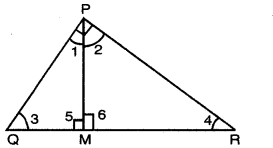
Proof: ∠P = 90° (Given)
∴ ∠1 + ∠2 = 90°
∠M = 900 (Given)
In ∆PMQ,
∠1 + ∠3 + ∠5 = 180°
=> ∠1 + ∠3 = 90° [Angle Sum Property] ………….(2) [∠5 = 90°]
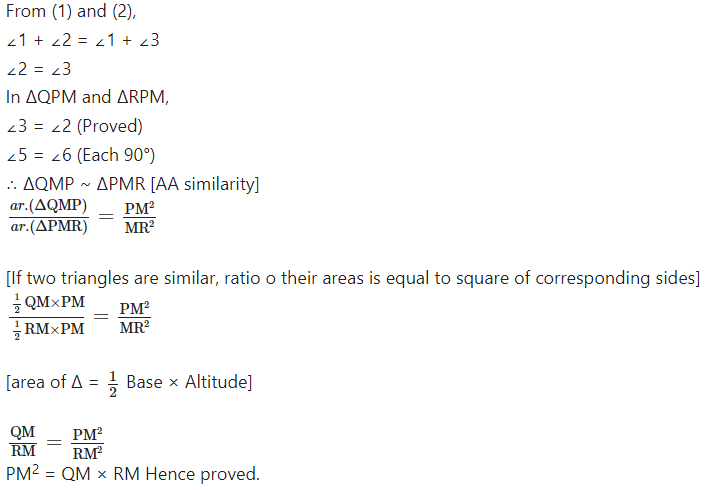
Question 3.
In fig., ABD is a triangle right angled at A and AC ⊥ BD. Show that
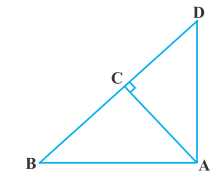
(i) AB2 = BC.BD
(ii) AC2 = BC.DC
(üi) AD2 = BD.CD.
Solution:
Given. A right angled ∆ABD in which right angled at A and AC ⊥ BD.
To Prove:
(i) AB2 = BC.BD
(ii) AC2 = BC.DC .
(iii) AD2 = BD.ÇD .
Proof. In ∆DAB and ∆DCA,
∠D = ∠D (common)
∠A = ∠C (each 90°)
∴ ∆DAB ~ ∆DCA [AA similarity]
In ∆DAB and ∆ACB,
∠B = ∠B (common)
∠A = ∠C . (each 90°)
∴ ∆DAB ~ ∆ACB, .
From (1) and (2),
∆DAB ~ ∆ACB ~ ∆DCA.
(i) ∆ACB ~ ∆DAB (proved)
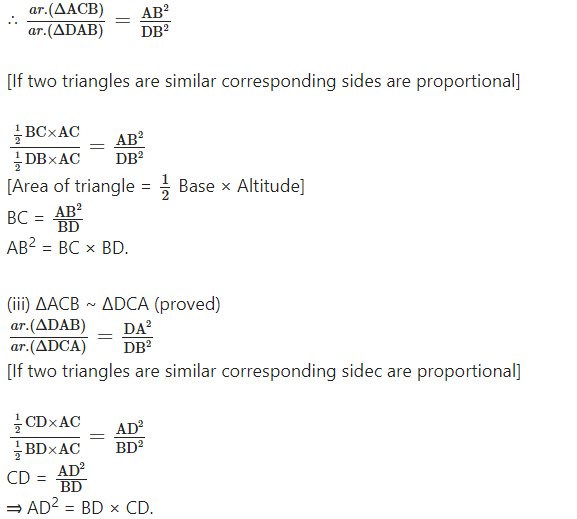
Question 4.
ABC is an isosceles triangle right angled at C. Prove that AB2 = 2AC2.
Solution:
Given: ABC is an isosceles triangle right angled at C.
To prove : AB2 = 2AC2.
Proof: In ∆ACB, ∠C = 90° & AC = BC (given)
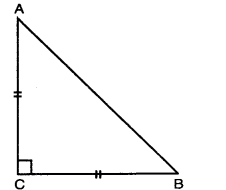
AB2 = AC2 + BC2
[By using Pythagoras Theorem]
=AC2 + AC2 [BC = AC]
AB2 = 2AC2
Hence proved.
Question 5.
ABC is an isosceles triangle with AC = BC. If AB2 = 2AC2, prove that ABC is right triangle.
Solution:
Given: ∆ABC is an isosceles triangle AC = BC
To prove: ∆ABC is a right triangle.
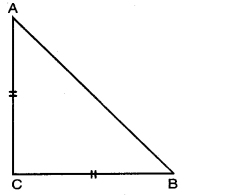
Proof: AB2 = 2AC2 (given)
AB2 = AC2 + AC2
AB2 = AC2 + BC2 [AC = BC]
∴ By Converse of Pythagoras Theorem,
∆ABC is right angled triangle.
Question 6.
ABC is an equilateral triangle of side 2a. Find each of its altitudes.
Solution:
∆ABC is equilateral triangle with each side 2a
AD ⊥ BC
AB = AC = BC = 2a
∆ADB ≅ ∆ADC [By RHS Cong.]
∴ BD = DC = a [c.p.c.t]
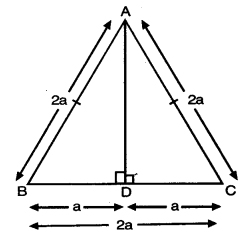
In right angled ∆ADB
AB2 = AD2 + BD2
(2a)2 = AD2 + (a)2
4a2 – a2 = AD2.
AD2 = 3a2
AD = √3a.
Question 7.
Prove that the sum of the squares of the sides of a rhombus is equal to the sum of the squares of its diagonals. [Pb. 2019]
Solution:
Given: Rhombus, ABCD diagonal AC and BD intersect each other at O.
To prove:
AB2 + BC2 + CD2 + AD2 = AC2 + BD2
Proof:The diagonals of a rhombus bisect each other at right angles.
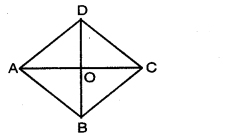
∴ AO = CO, BO = DO
∴ ∠s at O are rt. ∠s
In ∆AOB, ∠AOB = 90°
∴ AB2 = AO2 + BO2 [By Pythagoras Theorem] …………..(1)
Similarly, BC2 = CO2 + BO2 ……………..(2)
CD2 = CO2 + DO2 ……………(3)
and DA2 = DO2 + AO2 ……………….(4)
Adding. (1), (2), (3) and (4), we get
AB2 + BC2 + CD2 + DA2 = 2AO2 + 2CO2 + 2BO2 + 2DO2
= 4AO2 + 4BO2
[∵ AO = CO and BO = DO]
= (2AO)2 + (2BO)2 = AC2 + BD2.
Question 8.
In fig., O is a point In the interior of a triangle ABC, OD ⊥ BC, OE ⊥ AC and OF ⊥ AB. Show that
(i) OA2 + OB2 + OC2 – OD2 – OE2 – OF2 = AF2 + BD2 + CE2
(ii)AF2 + BD2 + CE2 = AE2 + CD2 + BF2.

Solution:
Given: A ∆ABC in which OD ⊥ BC, 0E ⊥ AC and OF ⊥ AB.
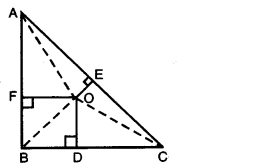
To prove:
(i) AF2 + BD2 + CE2 = OA2 + OB2 + OC2 – OD2 – OE2 – OF2
(ii) AF2 + BD2 + CE2 = AE2 + CD2 + BF2.
Construction: Join OB, OC and OA.
Proof: (i) In rt. ∠d ∆AFO, we have
OA2 = OF2 + AF2 [By Pythagoras Theorem]
or AF2 = OA2 – OF2 …………..(1)
In rt. ∠d ∆BDO, we have:
OB2 = BD2+ OD2 [By Pythagoras Theorem]
⇒ BD2 = OB2 – OD2 …………..(2)
In rt. ∠d ∆CEO, we have:
OC2 = CE2 + OE2 [By Pythagoras Theorem]
⇒ CE2 = OC2 – OE2 ……………(3)
∴ AF2 + BD2 + CE2 = OA2 – OF2 + OB2 – OD2 + OC2 – 0E2
[On adding (1), (2) and (3)]
= OA2 + OB2 + OC2 – OD2 – OE2 – OF2
which proves part (1).
Again, AF2 + BD2 + CE2 = (OA2 – OE2) + (OC2 – OD2) + (OB2 – OF2)
= AE2 + CD2 + BF2
[∵AE2 = AO2 – OE2
CD2 = OC2 – OD2
BF2 = OB2 – OF2].
Question 9.
A ladder 10 m long reaches a window 8 m above the ground. Find the distance of the foot of the ladder from base of the wall.
Solution:
Height of window from ground (AB) = 8m.
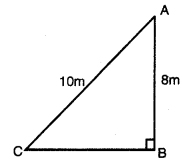
Length of ladder (AC) = 10 m
Distance between foot of ladder and foot of wall (BC) = ?
In ∆ABC,
AB2 + BC2 = AC2 [By Pythagoras Theorem]
(8)2 + (BC)2 = (10)2
64 + BC2 = 100
BC2 = 100 – 64
BC = √36
BC = 6 cm.
∴ Distance between fóot of ladder and foot of wall = 6 cm.
Question 10.
A guy wire attached to a vertical pole of height 18 m Is 24 m long and has a stake attached to the other end. How far from the base of the pole should the stake be driven so that the wire will be taut?
Solution:
Let AB is height of pole (AB) = 18 m
AC is length of wire = 24 m

Question 11.
An aeroplane leaves an airport and flies due north at a speed of 1000 km per hour. At the same time, another aeroplane leaves the same airport and flies due west at a speed of 1200 km per hour. How far apart will be the two pLanes after 1½ hours?
Solution:
Speed of first aeroplane = 1000km/hr.
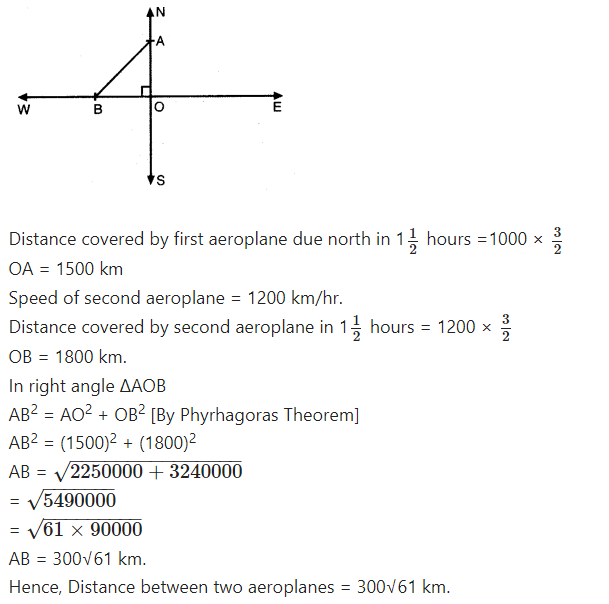
Question 12.
Two poles of heights 6 m and 11 m stand on a plane ground. If the distance between the feet of the poles is 12 m, find the
distance between their tops.
Solution:
Height of pole AB = 11 m
Height of pole (CD) = 6 m
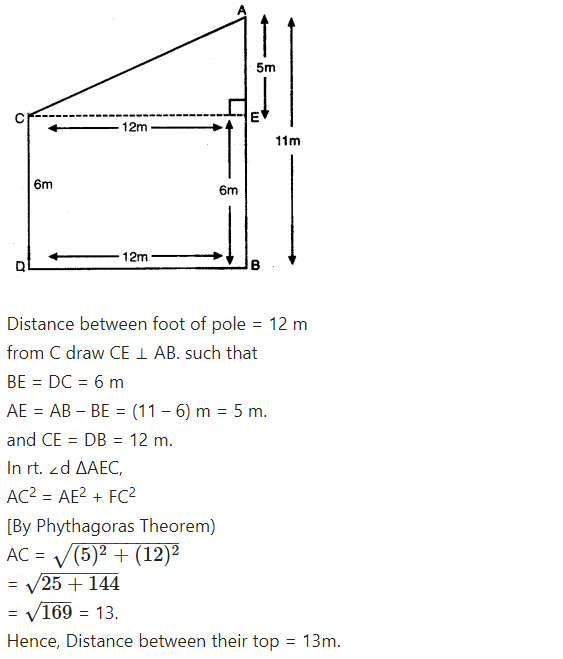
Question 13.
D and E are points on the sides CA and CB respectively of a triangle ABC right angled at C.
Prove that AE2 + BD2 = AB2 + DE2.
Solution:
Given: In right angled ∆ABC, ∠C = 90° ;
D and E are points on sides CA & CB respectively.
To prove: AE2 + BD2 = AB2 + DE2
Proof: In rt. ∠d ∆BCA,
AB2 = BC2 + CA2 …………..(1) [By Pythagoras Theorem]

In rt. ∠d ∆ECD,
DE2 = EC2 + DC2 ……………….(2) [By Pythagoras Theorem]
In right angled triangle ∆ACE,
AE2 = AC2 + CE2 ……………….(3)
In right angled triangle ∆BCD
BD2 = BC2 + CD2 ……………….(4)
Adding (3) and (4),
AE2 + BD2 = AC2 + CE2 + BC2 + CD2
= [AC2 + CB2] + [CE2 + DC2]
= AB2 + DE2
[From (1) and (2)]
Hence 2 + BD2 = AB2 + DE2.
Which is the required result.
Question 14.
The perpendicular from A on side BC of a ∆ABC intersects BC at D such that DB = 3 CD. Prove that 2AB2 = 2AC2 + BC2.

Solution:
Given: ∆ABC, AD ⊥ BC
BD = 3CD.
To prove: 2AB2 = 2AC2 + BC2.
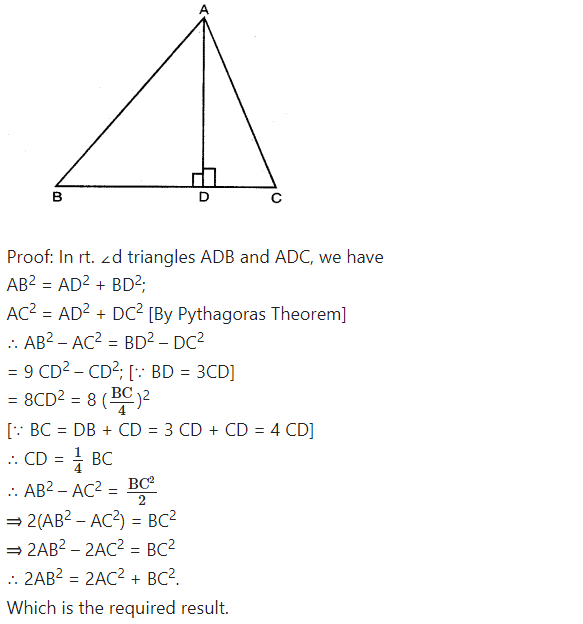
Question 15.
In an equilateral triangle ABC, D is a point on side BC such that BD = 1/3 BC. Prove that 9 AD2 = 7 AB2.
Solution:
Given: Equilateral triangle ABC, D is a point on side BC such that BD = 1/3 BC.
To prove: 9AD2 = 7 AB2.
Construction: AB ⊥ BC.
Proof: ∆AMB ≅ ∆AMC [By R.HS. Rule since AM = AM and AB = AC]

Question 16.
In an equilateral triangle, prove that three times the square of one side Ls equal to four times the square of one of its
altitudes.
Solution:
Given:
ABC is equilateral ∆ in which AB = BC = AC

To prove: 3 AB2 = 4 AD2
Proof: In right angled ∆ABD,
AB2 = AD2 + BD2 (Py. theorem)
AB2 = A BD2 (Py. theorem)
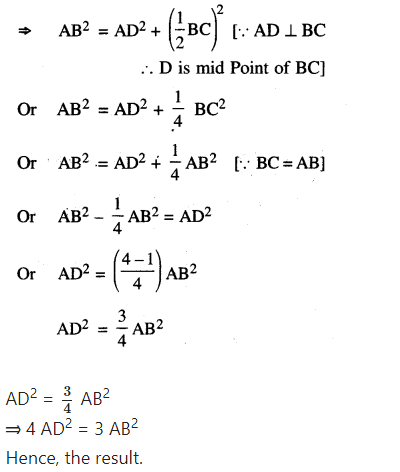
Question 17.
Tick the correct answer and justify: In ∆ABC, AB = 6 cm, AC = 12 cm and BC = 6√3 cm. [The angles of B are respectively
(A) 120°
(B) 64°
(C) 90°
(D) 45°
Solution.
AC = 12 cm
AB = 6√3 cm
BC = 6 cm
AC2 = (12)2 = 144 cm
AB2 + BC2 = (6√3)2 + (6)2
= 108 + 36
AB√3 + BC√3 = 144
∴ AB√3 + BC√3 = AC√3
Hence by converse of pythagoras theorem ∆ABC is right angred triangle right angle at B
∴ ∠B = 90°
∴ correct option is (C).
Follow on Facebook page – Click Here
Google News join in – Click Here
Read More Asia News – Click Here
Read More Sports News – Click Here
Read More Crypto News – Click Here